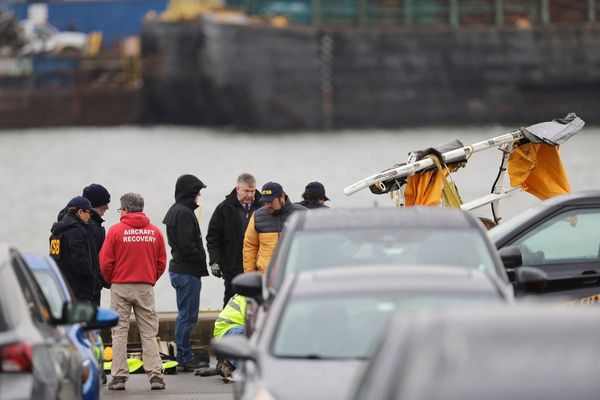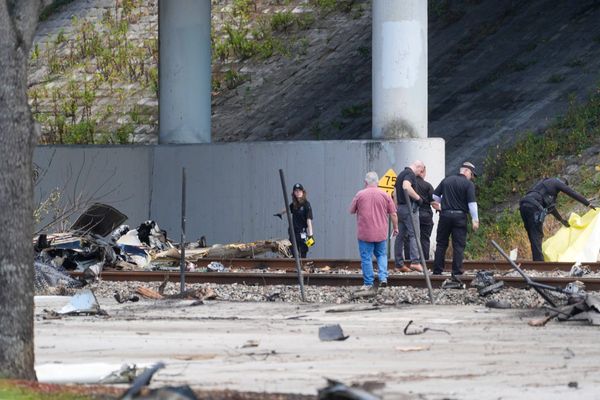A colonial homestead built for Canberra pioneer George Harcourt that withstood a major bushfire, over a century of wear from residents and the development of the national capital, has not survived the Mr Fluffy asbestos disaster.
Excavators have torn down the heritage-listed 'Deasland' in a sanctioned demolition, reducing the "exceptionally well-built" 1893 timber home to a pile of toxic waste.
Its most recent long-term owner, John MacKinnon, watched on as the house he maintained and restored over 46 years came crashing down.
He and his late wife Chris raised their three children at Deasland and ran sheep and cattle on the 1,100-acre property.
"It was an ideal place for having a family, so close to amenities and schools but also in the country, basically."
Driving down the Barton Highway, motorists would have spotted Deasland with its striped tin roof and charming verandahs at what is now Gold Creek, an eclectic mix of old buildings and modern tourist attractions.
The homestead stood as a relic, gradually built in on all sides by the suburb of Nicholls, a golf course, a petrol station and towering dinosaur statues outside the National Dinosaur Museum.
Mr MacKinnon does not know who installed the loose-fill asbestos insulation, which came to be known as Mr Fluffy asbestos, in the property prior to 1975 when he moved in.
But, he was aware of the dangers and insisted the government remove it, which it eventually did.
Then, when the Commonwealth's large-scale inspection program commenced in the 1990s it was cleaned again.
But it was earmarked for demolition in 2014, along with over 1,000 other homes in the capital, by the ACT's Asbestos Response Taskforce, which decided that was the "only enduring solution" to the health risks of the deadly legacy.
"Meter readings were taken … and there was very little [asbestos] actually showed up but I suppose as we know now that it only takes one minuscule piece to cause some damage," Mr MacKinnon said.
While he understands the reasoning behind the decision, it still leaves a bitter taste.
A year ago Mr MacKinnon sold the whittled-down property to a private buyer, rejecting the ACT government's buyback offer, and it was the new owner who oversaw the demolition earlier this month.
"It still gripes me that we were told the buildings, this one and others as well, had to be demolished and yet we still ended up in not such a good place financially to do that," Mr MacKinnon said.
A bright yellow sign fixed to a high fence around the property gives an insight into how the current owners feel. It reads:
"Unfortunately this house has to be removed due to Mr Fluffy asbestos. It is not our preference to demolish the house. It is out of our control."
An end to Deasland's 'golden age'
Perhaps Deasland's most famous resident was the self-made man of the golden fleece — Henry 'Babe' Curran, whose top pastures now lie beneath the homes in the suburb of Ngunnawal.
Babe Curran became Australia's premier woolgrower, setting world record prices for a flock primarily pastured at Ginninderra in the late 1940s and 1950s. Curran was also an accomplished cricketer, tennis player, athlete and footballer.
Curran's grandson and historian James McDonald has written extensively about Deasland, especially the Curran tenure of 44 years, calling it "the golden age of Deasland's history".
Mr McDonald said he held out hope the "inevitable" demolition of the homestead would not happen and it had caused great distress to local family members when it did.
"It was important as a landmark in Canberra's pastural history but also it had lots of personal memories for us, which was a little bit sad."
Mr McDonald recalls darting between the homestead and adjacent historic brick dairy to pour himself a cup of cream to indulge in with his brother John and sister Janet.
"Quite often with my uncle Richard we'd go up and milk the cow, bring the pail of milk back to the dairy put it straight through the separator and out came a cup of cream to drink straight from it. It was an absolute luxury," he said.
The dairy was unaffected by the Mr Fluffy asbestos and was required to be kept on the property, along with a machinery shed and tennis court.
Deasland oldest heritage home with Mr Fluffy demolished
A total of 25 residential heritage properties with loose-fill asbestos insulation have been demolished, of which Deasland is the oldest.
Phil Robson, Collections Manager at the Hall School Museum and Heritage Centre, said Deasland's destruction was a big loss.
The neighbouring derelict blacksmith's shop, a schoolhouse and church from the Ginninderra era remain on that side of the highway, where visitors more commonly flock to boutique shops and the tiny village of Cockington Green.
"As someone said to me once, 'it's called progress', and I'm not against progress but I think progress can be done a bit more selectively and carefully and integrating heritage aspects," Mr Robson said.
Deasland was heritage listed in 1993, its significance being an "exceptionally well-built" homestead that was a "particularly fine example of Australian carpentry craftsmanship and construction".
Because of this, and the cultural history of Deasland — as the home of George Harcourt and Babe Curran — Mr Robson lodged an objection with the minister and suggested it be remediated to be used as a house museum with casual visitors.
But the ACT Heritage Council had already advised it would not object to the demolition, in the interests of the health and safety of occupants and visitors.
"When I think of other buildings around the ACT that the ACT Historic Houses Trust looks after like Mugga, Calthorpes' House, Blundells Cottage, Lanyon Homestead I mean they're beautifully looked after and have been carefully managed and I can't see why Deasland didn't fall into that category," Mr Robson said.
The Curran family also made attempts to save at least part of the Deasland property for future generations.
They appealed to the ACT government to quarantine a section for a small plaque to acknowledge the history of the homestead and possibly for broader Mr Fluffy commemorations but said they received a hostile response from the Asbestos Response Taskforce at the time.
It is understood the current owners of the property plan to build a single dwelling family home which must conform with any heritage guidelines and its design be considered by the ACT Heritage Council.







